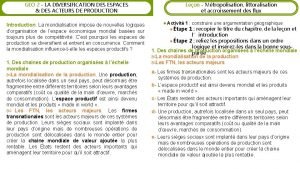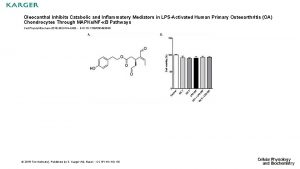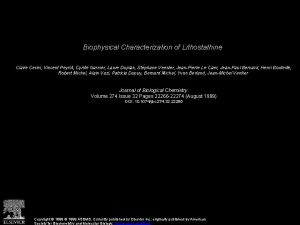Oleocanthal Discovery and Potential Catherine Peyrot des Gachons














































- Slides: 46

Oleocanthal: Discovery and Potential Catherine Peyrot des Gachons and Gary K. Beauchamp Monell Chemical Senses Center July 4, 2016

The Senses Vision Hearing Touch Smell Taste

The Senses: Impact of Loss Vision Hearing Touch Smell Taste

The Senses: Health Impact Vision Hearing Touch Smell Taste

Monell Chemical Senses Center is an independent non-profit research institute founded in 1968, based in Philadelphia, USA. Its mission is to advance scientific understanding of the mechanisms and functions of taste and smell.

Galen on Taste Function Galen thought that the safest way to identify drugs was by tasting: “Taste differentiates most [pecularities (sic)] of drugs whereas the sense of smell confirms poorly, as one says. ” R. E. Siegel, Galen On sense Perception, Karger: Basel, Switzerland, 1970.

Brazil: Can organoleptic properties explain differential use of medicinal plants? “The “taste” and smell of a plant can influence its differential medicinal use” Medeiros e. al. , J. Ethnopharmacology, 2015

Mexico: Organoleptic properties as selection properties for medicinal plants Indigenous healers: “every plant is a potential medicine. ” “Taste” helps to identify Leonti et al. , J. Ethnopharmacology, 2002

India: Concept of Rasa (“taste”) in Ayurveda Taste (Rasa): Bitter Astringent Pungent Sour Salty Sweet “Taste assessment may be a preliminary step in the screening process of an unknown plant in Ayurvedic pharmacology” Gilea & Barbulescu, J. Ethnopharmacology, 2015

Borneo: Sensory attributes of medicinal plants among the Kenyah Leppo Ke Describing “taste” properties of medicinal plants: Bitter Astringent “Sanit, ” piquant, spicy, burning or stinging Sour, tart Sweet Salty or potent, strong Irritating, burning, itchy “Jeleme, ” umami, msg “Many native systems utilize organoleptic indicators for assembling their pharmacopoeia, favoring certain sensory cues” Gollin, J. Ethnobiology, 2004

Summary The “taste” of a plant assists in identifying medicinal use in many cultures. By taste most cultures include taste (in the strict sense) and irritation (chemesthesis) in its definition

“Gustatory Pharmacology”

Fischer & Griffin, 1964


Ibuprofen A widely used anti-inflammatory drug – blocks COX-1 and COX-2 Relieves pain In some ways mimics aspirin without many of the side effects Long-term consumption has been reported to reduce the risk of heart disease and some forms of cancer and to delay the onset of Alzheimer’s disease “Tastes bad”

Ibuprofen sensations Intensity (Geo. M) Ibupofen 24 Ibupofen 21 Mouth Irritation + Na. Bicarb 18 Mod 15 12 9 Weak 6 3 Barely Detect 24 21 Throat Irritation 18 Mod 15 12 9 Weak 6 3 Barely Detect 24 Taste 21 18 Mod 15 12 9 Weak 6 3 Barely Detect 0 0 5 10 15 20 Time (min) Breslin, Gingrich & Green, Chem Senses, 2001 Ibuprofen: Strong Throat Irritation

Molecular Gastronomy: Erice, Sicily, 1999

Sensory attributes may predict physiological activity • Fisher & Griffin (1964): The oral cavity is a pharmacological preparation in situ. • Health benefits of mediterranean diet include: Reduced incidence of some forms of cancer Reduced incidence of neurodegenerative diseases such as Alzheimers Reduced incidence of heart disease • Is the throat irritating property in extra virgin olive oil, like ibuprofen, an antiinflammatory?

Isolation of throat-localized pungency in extra virgin olive oil Beauchamp et al. , Nature: 2005

Throat stinging compound: (-)-decarbomethoxy-dialdehydic ligstroside aglycone Oleocanthal (oleo = olive; canth = sting; al = aldehyde) Montedoro et al. , J Ag Food Chem: 1992. Andrewes et al. , J Ag Food Chem: 2003. Beauchamp et al. , Nature: 2005

Oleocanthal: 13 step synthetic scheme (+)- and (-) Oleocanthal Smith et al, 2005

COX-1 and COX-2 inhibition test Oleocanthal inhibits the cyclooxygenases (Cox 1 and Cox 2) thereby reducing inflammation (data not shown) Confirming phamarcological similarities between OC and Ibuprofen Beauchamp et al. , Nature: 2005

Is this similar pharyngeal irritation mediated by the same receptor? And if yes, which one? Peyrot des Gachons, et al. (2011). Journal of neuroscience, 31(3), 999 -1009.

Pungency is mediated by activation of nociceptors on the trigeminal nerve fibers

Calcium imaging on cultured rodent trigeminal neurons (neural activity in vitro model) Fluorescence ratio (340/380) stimulus • Comparison with other stimuli • Use of specific receptor blockers Peyrot des Gachons, et al. (2011)

Oleocanthal activation in rodent TG neurons AITC sensory receptor: TRPA 1

Use of genetically modified mice: TRPA 1 knockout mice (=non functional TRPA 1) Oleocanthal activation in cultured cell lines expressing human TRPA 1 channels

Ibuprofen activation in TG neurons and cells expressing human TRPA 1 channel Oleocanthal and ibuprofen exclusively activate the sensory receptor TRPA 1

TRP proteins play critical roles in sensory physiology • Transient receptor potential (TRP) channel family play critical roles in the responses to all major classes of external stimuli: chemicals, light, temperature, and touch. • TRP channels are subject modulation and regulation to extensive

Other TRPA 1 agonists display different sensory profile than OC/Ibu (irritate whole oral cavity)

Immunohistochemical TRPA 1 analyses of human oral tissues ANTERIOR TONGUE THROAT TISSUE

Immunohistochemical TRPA 1 analyses of human lingual and nasal tissues

• In humans, TRPA 1 is richly expressed in nerve fibers in the pharyngeal and nasal epithelia but not in fibers innervating anterior tongue, including taste buds. • Overlap between expression pattern of TRPA 1 and OC irritation location which suggests that this channel mediates the upper airway tissue sensitivity to OC. • The TRPA 1 agonists, which irritate the anterior tongue in humans, may do so via: - Activation of additional ion channels - tissue specific expression of TRPA 1 variant or heteromers, that does not react with our human TRPA 1 antibody

Conclusion The differences observed in perceptual profiles are indicators of differences in sensory receptor expression.

Importance of TRP channels in health • Cellular sensors involved in: pain sensation, taste perception, thermosensation, mechano and osmolarity sensing • Important in normal physiology: involved in signal transmission • Implicated in various disease states

Importance of TRPA 1 channel in health • TRPA 1 is central to the mediation of pain sensation, vascular dilation, airway disease, itch and inflammation. • TRPA 1 is primarily expressed in sensory neurons, but also present in non-neuronal tissues such as heart, small intestine, lung and pancreas. • “Because TRPA 1 mediates neuropathic pain, and [those] other functions, it has the potential to be an excellent drug target. ”* *Kozai et al. , Current Neuropharmacology 13, 2015

• Few antagonists are currently tested in clinical trials for pain control. • Animal studies suggest that therapeutic value of TRPA 1 antagonists extends beyond pain, to severe itching, asthma and cough. • Inhibition of TRPA 1 seems the most logical approach for drug development, nevertheless several studies have shown that certain activators, including acetaminophen metabolites, display antinociceptive properties via activation of TRPA 1, or via desensitization of the receptor.

Relationship between sensory response and pharmacological activity

Two compounds of interest in EVOO Oleocanthal Oleacein

Both oleocanthal and oleacein are anti-inflammatory Peyrot des Gachons et al. , unpublished

Both oleocanthal and oleacein elicit trigeminal neuron activity Peyrot des Gachons et al. , unpublished

Oleacein does not seem to elicit strong human throat irritation Control Oleacein Oleocanthal Peyrot des Gachons et al. , unpublished

Oleacein apparently does not elicit human throat irritation Control Oleacein Oleocanthal Why? Does it highlight in vivo differences in TRPA 1 access?

Future Research • TRPA 1 channels are molecular sentinels of cellular stress, tissue damage and potentially harmful compounds (such as many pollutants). • The peculiar sensory profile of Oleocanthal (pharyngeal pungency and weak cough elicitor) seem particularly adapted to the study of TRA 1 involvement in asthma, cough and other respiratory disease. • TRPA 1 activation should also be studied when considering OC and EVOO health benefits.

Scientific Collaborators Gary K. Beauchamp Paul A. S. Breslin Maureen O’Leary Current Collaborators Amos B. Smith III Bruce Bryant Jeffrey B. Sperry Russell Keast Diane Morel Jianming Lin Jana Pika Makoto Tominaga Asako Shima Quiang Han Chi-Ho Lee Past Collaborators

Monell Chemical Senses Center www. monell. org Monell. Center @Monell. Sc
 Catherine peyrot des gachons
Catherine peyrot des gachons Des des des
Des des des Graded potential vs action potential
Graded potential vs action potential Define electric potential and potential difference.
Define electric potential and potential difference. Electrostatic potential difference
Electrostatic potential difference Osmosis equation
Osmosis equation Sales potential vs market potential
Sales potential vs market potential Electric potential
Electric potential Define electrical potential difference
Define electrical potential difference V=pe/q
V=pe/q What is electrical potential
What is electrical potential Flaccid cell
Flaccid cell ψs
ψs Graded potential vs action potential
Graded potential vs action potential Definition of graded potential
Definition of graded potential Graded potential vs action potential
Graded potential vs action potential Saltatory conduction
Saltatory conduction Osmotic potential vs water potential
Osmotic potential vs water potential Source of bioelectric potential is
Source of bioelectric potential is Hypopolarization
Hypopolarization Rocuronium dose
Rocuronium dose Action potential resting potential
Action potential resting potential Action potential resting potential
Action potential resting potential Electrical potential energy
Electrical potential energy Double des and triple des
Double des and triple des La diffusion des idées des lumières
La diffusion des idées des lumières Il existe des personnes qui sont des lumières pour tous
Il existe des personnes qui sont des lumières pour tous Temps verbaux et leurs valeurs
Temps verbaux et leurs valeurs Plan marshall affiche
Plan marshall affiche Diversification des espaces et des acteurs de la production
Diversification des espaces et des acteurs de la production Volume d un corps
Volume d un corps Mesure de niveaux pour liquides et solides
Mesure de niveaux pour liquides et solides Cartographie des flux
Cartographie des flux Je t'offrirai des fleurs et des nappes en couleurs
Je t'offrirai des fleurs et des nappes en couleurs Robin des bois des alpes
Robin des bois des alpes Budget des ventes méthode des moindres carrés
Budget des ventes méthode des moindres carrés Business accounting and finance catherine gowthorpe
Business accounting and finance catherine gowthorpe Wuthering heights chapter 29 summary
Wuthering heights chapter 29 summary Catherine olivieri
Catherine olivieri Did catherine parr have children
Did catherine parr have children Famous intrepreneurs
Famous intrepreneurs Catherine armand
Catherine armand Catherine moynihan
Catherine moynihan Boyaval catherine france
Boyaval catherine france Catherine bougault
Catherine bougault Catherine bosshart
Catherine bosshart Une cole
Une cole


































































